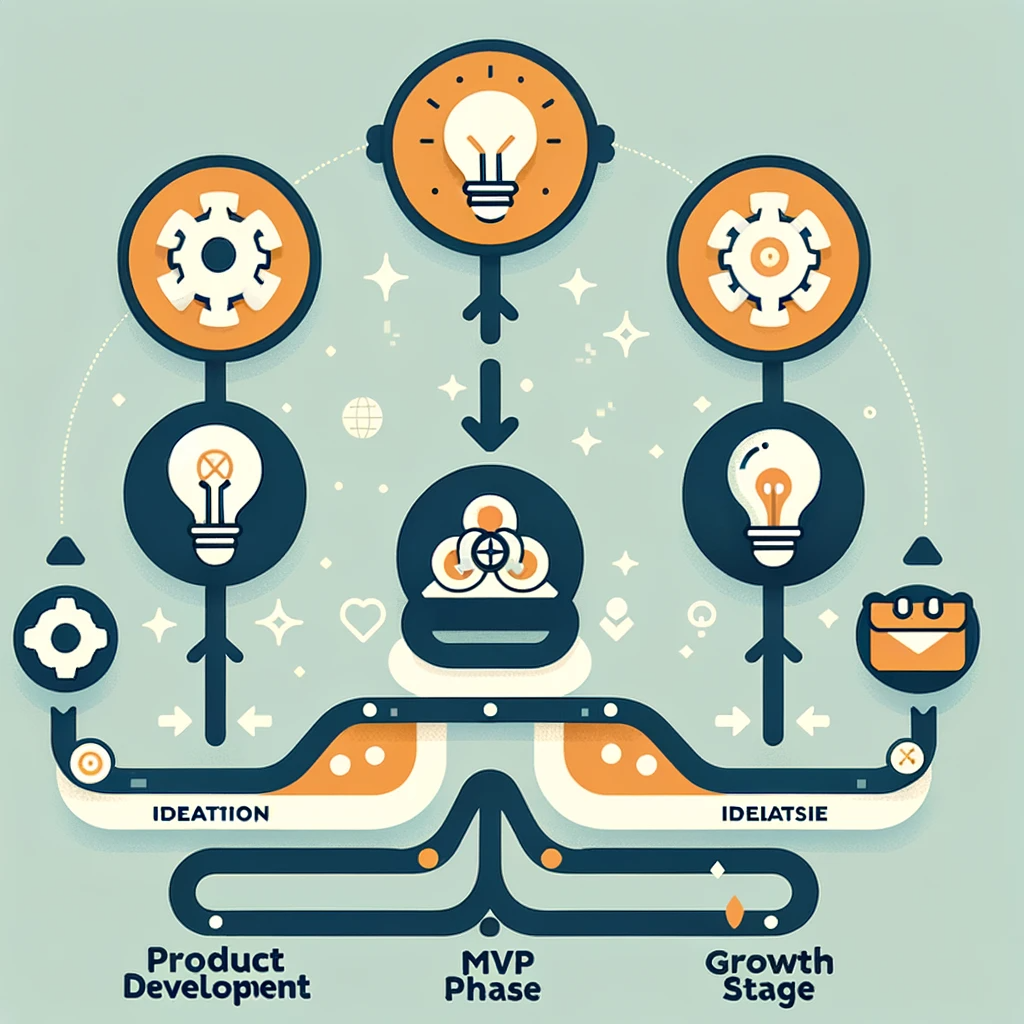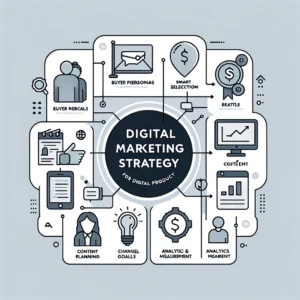The difference between success and failure often hinges on effective strategic planning. Strategic planning is not just a high-level corporate exercise; it’s a fundamental process that guides a product from a mere concept to a market-ready entity and beyond.

For beginners in product development, understanding the role of strategic planning at each stage – from ideation, through the Minimum Viable Product (MVP) phase, to growth – is crucial. This guide serves as a beginner-friendly roadmap, outlining the essentials of strategic planning in product development and illustrating how to navigate each stage with foresight and agility. Whether you’re an aspiring entrepreneur, a startup team member, or a product manager, this guide will help you grasp the principles of strategic planning that can propel your product to success.
The Essence of Strategic Planning in Product Development
What is Strategic Planning in Product Development?
Strategic planning in product development involves outlining a long-term vision for a product and establishing the steps necessary to bring that vision to life. It’s about understanding market trends, identifying customer needs, and developing a coherent plan that aligns product development efforts with these insights. Strategic planning is not a one-time task but a continuous process that evolves as the product moves through different stages of its lifecycle.
The planning phase encompasses a range of activities, from defining the product’s unique value proposition to setting realistic timelines and milestones. It requires a blend of creativity, analytical thinking, and practical decision-making. Effective strategic planning ensures that product development is focused, goal-oriented, and adaptable to changing market conditions and customer feedback.
Key Benefits and Importance at Each Stage
At the ideation stage, strategic planning helps in conceptualizing a product that is not only innovative but also viable and marketable. It guides the brainstorming process, ensuring that ideas are not just imaginative but also grounded in market reality. During the MVP phase, strategic planning plays a critical role in determining the core features of the product, deciding on the feedback mechanisms, and preparing for potential pivots based on user responses. In the growth stage, strategic planning is essential for scaling the product, exploring new markets, and sustaining innovation.
Strategic planning brings several benefits across all stages of product development. It provides a clear direction, helps in resource allocation, reduces risks, and enhances the ability to adapt to changes. It also ensures that all stakeholders are aligned with the product vision, which is crucial for cohesive and efficient progress.
Strategic Planning in the Ideation Stage
Brainstorming and Conceptualizing Product Ideas
The ideation stage is where the journey of a product begins, and strategic planning here lays the foundation for its future. Brainstorming and conceptualizing product ideas is not just about creativity; it’s about aligning those ideas with business objectives and market needs. Strategic planning at this stage involves gathering insights about the target market, understanding customer pain points, and identifying gaps in the current market offerings. It’s about asking the right questions: What problem does the product solve? Who is it for? What makes it different from existing solutions?
A strategic approach to brainstorming involves leveraging tools like mind mapping, SWOT analysis (Strengths, Weaknesses, Opportunities, Threats), and competitor analysis. These tools help in systematically exploring ideas and evaluating their potential. The goal is to converge on a set of ideas that are not only innovative but also feasible, valuable to the target audience, and aligned with the company’s strengths and market opportunities.
Market Research and Feasibility Analysis
Market research is an integral part of strategic planning in the ideation stage. It involves gathering and analyzing data about potential customers, competitors, and the overall market environment. This research helps in validating the demand for the product idea, understanding the competitive landscape, and identifying any potential challenges in bringing the product to market.
Read more about strategic planning and execution
Feasibility analysis goes hand in hand with market research. It’s about assessing whether the product idea can be turned into a viable business opportunity. This includes evaluating technical feasibility, financial viability, and operational aspects. Strategic planning at this stage ensures that the product idea is not only desirable but also technically possible and financially sustainable.
Setting Clear Objectives and Vision

The final step in strategic planning during the ideation stage is setting clear objectives and a vision for the product. This involves defining what success looks like for the product and establishing measurable goals. Objectives might include specific milestones for product development, market entry timelines, sales targets, or user acquisition goals.
A well-defined vision and objectives provide a clear direction for the team and help in maintaining focus throughout the product development process. It also serves as a benchmark against which the progress of the product can be measured and evaluated.
Navigating the MVP Phase with Strategic Planning
Designing Your Minimum Viable Product
The MVP phase is a critical stage in product development, where strategic planning focuses on creating a product with just enough features to satisfy early customers and provide feedback for future development. This phase is about balancing what is desirable from a user’s perspective with what is viable from a business standpoint and feasible from a technological perspective.
Designing an MVP requires a clear understanding of the core features that will address the primary needs of your target audience. Strategic planning here involves prioritizing features based on their importance and impact, ensuring that the MVP is not overburdened with unnecessary functionalities. This stage is also about setting clear metrics to measure the success of the MVP, such as user engagement, feedback, and the rate of adoption.
Testing and Iteration: Gathering Feedback
Once the MVP is launched, the focus shifts to gathering and analyzing user feedback. Strategic planning in this phase involves creating efficient channels for collecting feedback, such as surveys, user interviews, and analytics tools. This feedback is crucial for understanding how the product is being used, what users like and dislike about it, and what improvements or additional features are needed.
Iterating the product based on this feedback is a key aspect of strategic planning. It involves making informed decisions about which changes to implement and how to prioritize them. The goal is to enhance the product iteratively while keeping it aligned with the overall strategic vision and objectives.
Preparing for Scaling: Setting the Stage for Growth
The MVP phase is not just about testing and improving the product; it’s also about preparing for the next stage – growth. Strategic planning at this point involves identifying the criteria for scaling, such as achieving a certain number of users, reaching specific revenue goals, or ensuring a stable and scalable infrastructure.
Preparation for scaling also includes planning for the resources needed for growth, such as funding, talent acquisition, and expanding operational capabilities. It’s about creating a roadmap that outlines how the product will evolve from the MVP to a fully-fledged product ready for a broader market.
Strategic Planning for Growth and Expansion
Scaling Your Product Effectively
As your product moves from the MVP phase to the growth stage, strategic planning becomes crucial in scaling your product effectively. This stage is about expanding your product’s reach and impact while maintaining its core value proposition. Scaling involves not just increasing the user base or entering new markets but also enhancing the product’s features, improving user experience, and ensuring that the infrastructure can handle increased demand.
Effective scaling requires a deep understanding of the market dynamics, customer behavior, and emerging trends. It’s essential to have a strategy for how to grow without compromising the quality of the product or the user experience. This might involve investing in technology, expanding the team, or forming strategic partnerships. The key is to make decisions that are data-driven and aligned with the long-term vision of the product.
Market Expansion and Diversification Strategies
Market expansion and diversification are integral parts of the growth stage. Strategic planning here involves identifying new markets or customer segments that the product can cater to. This could mean localizing the product for different regions, adapting it for different customer segments, or even diversifying the product line.
Developing a market expansion strategy requires thorough research to understand the needs and preferences of the new market. It also involves assessing the competition and potential barriers to entry. Diversification, on the other hand, might require innovation and development of new features or complementary products, ensuring that they are in line with the overall brand and business objectives.
Long-term Vision: Sustaining Growth and Innovation
Sustaining growth over the long term is one of the biggest challenges in product development. Strategic planning for long-term growth involves continuously monitoring the market, adapting to changes, and innovating. It’s about staying ahead of the curve, anticipating customer needs, and being prepared to pivot when necessary.
A long-term vision for the product should include plans for continuous improvement and innovation. It might involve setting up a dedicated research and development team, investing in new technologies, or exploring new business models. The goal is to keep the product relevant and competitive in an ever-changing market.
Best Practices and Common Challenges in Strategic Planning
Incorporating Flexibility and Adaptability
In the realm of product development, strategic planning must be flexible and adaptable. The market is dynamic, and customer preferences can change rapidly. Best practices in strategic planning involve setting up processes that are agile and can respond to market changes swiftly. This means having a plan that is not rigid but allows for adjustments and pivots without derailing the overall strategy.
Incorporating flexibility into your strategic planning might include regular review and adjustment periods, fostering a culture of continuous learning and innovation, and being open to feedback from all stakeholders. This approach ensures that your product stays relevant and can adapt to unforeseen challenges or opportunities.
Overcoming Obstacles in Product Development
Product development is fraught with challenges, ranging from technical hurdles to market competition. Strategic planning helps in anticipating these challenges and preparing for them. Common obstacles include technological constraints, funding shortages, regulatory issues, and changing market trends.
Overcoming these obstacles requires a proactive approach. This could involve risk assessment and management strategies, securing backup funding sources, staying abreast of regulatory changes, and continuous competitor analysis. A robust strategic plan anticipates potential problems and includes contingency plans to address them.
Continuous Improvement and Agile Methodologies
Continuous improvement is a key principle in product development. It involves regularly evaluating and improving the product, processes, and strategies. Integrating agile methodologies into strategic planning can greatly enhance this continuous improvement process. Agile methodologies emphasize flexibility, iterative development, customer feedback, and cross-functional collaboration.
Adopting an agile approach in strategic planning means breaking down the product development process into smaller, manageable stages, allowing for regular feedback and adjustments. It encourages a customer-centric approach, where user feedback is integrated into the development process, leading to products that better meet customer needs.
Conclusion
Strategic planning is an indispensable tool in the product development process, guiding products from ideation to growth. It involves setting a clear vision, aligning product development with market needs, and being prepared to adapt to changes. By following best practices and overcoming common challenges, product developers can ensure their products not only reach the market but thrive and evolve over time.



